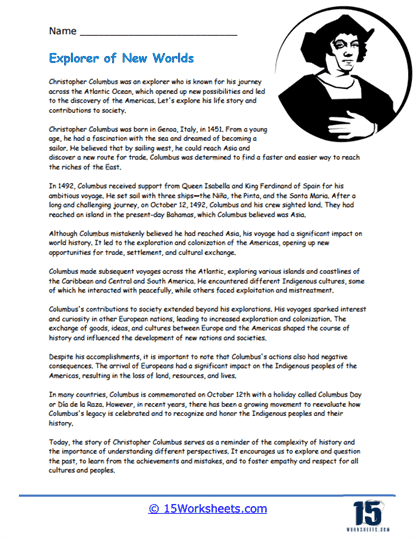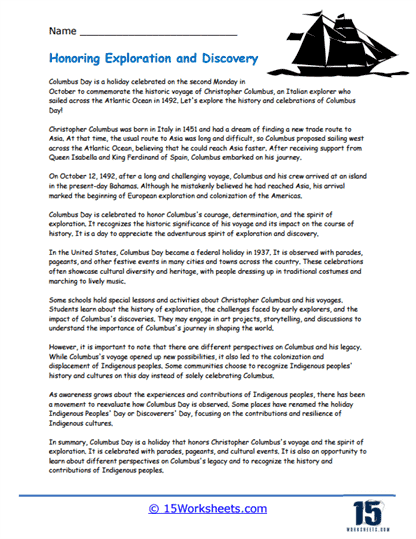Columbus Day Worksheets
What is Columbus Day?
Columbus Day is a U.S. holiday that commemorates the landing of Christopher Columbus in the Americas on October 12, 1492. Columbus was an Italian explorer who completed four voyages across the Atlantic Ocean, opening the way for widespread European exploration and the eventual conquest of the Americas by Europeans.
The holiday is observed on the second Monday in October. It was first celebrated in the late 18th century by Italian-Americans as a way to honor Columbus’ Italian heritage and the impact his discoveries had on world history. In 1937, it became a federal holiday in the United States.
However, the observance of Columbus Day has been controversial due to the violent and oppressive treatment of Indigenous peoples that followed in the wake of Columbus’ voyages. Because of this, some places in the U.S. have moved to instead celebrate Indigenous Peoples’ Day or Native American Day on the same date as Columbus Day. This alternative celebration honors the cultures, histories, and contributions of Native peoples who were already living in the Americas when Columbus arrived.
Who Was Christopher Columbus?
Christopher Columbus (1451-1506) was an Italian explorer, navigator, and colonizer who is most famous for his 1492 voyage from Spain to the Americas, which he didn’t know existed. His voyage was sponsored by the Spanish monarchs Ferdinand II of Aragon and Isabella I of Castile. Columbus made a total of four trips to the Caribbean and South America during the years 1492-1504.
Although Columbus was not the first European explorer to reach the Americas (having been preceded by the Norse expedition led by Leif Erikson in the 11th century), his voyages led to the first lasting European contact with the Americas, inaugurating a period of exploration, conquest, and colonization that lasted several centuries. These voyages thus had significant historical impact, marking the beginning of the widespread exchange of plants, animals, cultural ideas, human populations (including slaves), communicable diseases, and ideas between the Eastern and Western hemispheres that is known as the “Columbian exchange”.
Christopher Columbus’s voyages were primarily sponsored by the Catholic Monarchs of Spain, King Ferdinand II of Aragon and Queen Isabella I of Castile. At the time, many European kingdoms were trying to find new trade routes to Asia, especially routes that would allow them to avoid the Ottoman Empire, which controlled the land routes.
Columbus proposed a plan to reach the East Indies by sailing west, as opposed to the traditional route which was to sail east. The Spanish monarchs agreed to finance his trip, providing ships (the Nina, the Pinta, and the Santa Maria) and crew for the voyage. Columbus himself was also given a series of privileges, should he succeed, including the title of Admiral of the Ocean Sea and a portion of all profits made from his discoveries.
Despite his voyages ultimately not reaching the East Indies as he had proposed, they nonetheless had a profound and lasting impact, leading to ongoing European exploration and eventual colonization of the Americas.

















